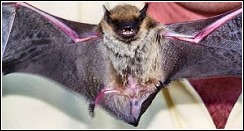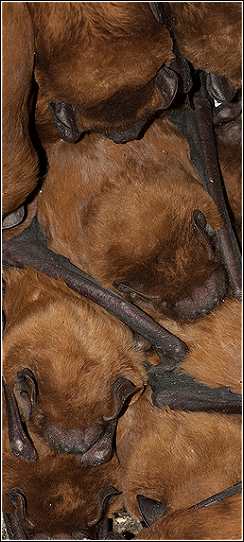Types Of Bats In Florida
In all, there are over 1000 species of bats in the world, about 45 common species in the United States, and according to the Florida Bat Conservancy there are 13 species in Florida. Common types of bats found in Southwest Florida include the Brazilian free-tailed (also referred to as the Mexican free-tailed), eastern pipistrelle, big brown, seminole, and evening bat.
Common Species
Through the years, popular literature, myths, and movies, along with the bat's sometimes sinister appearance, have given bats a reputation as something to be feared. However, under the proper circumstances, they can be quite beneficial. For instance, some bats can consume thousands of mosquitoes in just one night and others such as fruit bats help pollinate crops and vegetation.
In Southwest Florida, the Brazilian free-tailed and evening bat are quite common. The big brown bat is also found in Florida but is most prevalent in the northern half of the state.
In general, bat species can differ in several ways, including how (or if) they hibernate, type of fur, coloring, flight capabilities, roosting preferences, hunting preferences, habitat, mating behavior and diet habits.
Brazilian Free-tailed Bat (Tadarida brasiliensis)
The Brazilian and Mexican free-tailed bats are one in the same. Which common name they are identified by will usually depend on what part of the country they are being discussed. The Brazilian free-tailed bat is often called the "farmer's friend" because they feed on insects that otherwise might be a problem for crops.
Mexican Free-tailed bat colonies can grow quite large, the colony in Bracken Cave near San Antonio, Texas is said to contain over 20 million.
The below photo shows what is said to be the largest urban bat colony in the world, found under the Congress Street bridge in Austin, Texas. Each evening over 1.5 million Mexican Free-tailed bats fly out from under the bridge as tourist and locals alike watch them take off.

The Congress Street Bridge
The large concentration of Brazilian free-tailed bats in Texas alone can consume over 1,000 tons of insects a night. Colors range from dark brown to grey. Their unique tail gave them their name, as it protrudes "freely" beyond the tail membrane. Free-tails have one young, and give birth between the first and third weeks of June.
Evening Bat (Myotis lucifigus)
The evening bat is a colonizing bat and one of the species commonly found clustered together in attics. It is believed that the evening bat prefers trees and man made structures to caves.
When we see bat problems in Cape Coral, Fort Myers, Pine Island, Sanibel Island, Boca Grande and other communities in the area, this species is often the culprit, second only to the Brazilian free-tailed bat. Evening bats are on the smaller side and are easily mistaken for a juvenile big brown, however, the big brown bat is not nearly as common in Southwest Florida as it is in the northern half of the state.
Big Brown Bat (Eptesicus fuscus)
About four to five inches in length, the "big" brown bat can have a wingspan of twelve to thirteen inches across. Their animal fur, or hair if you prefer, is rather long, and can range in color from a shiny brown, to pinkish tans, to rich chocolates or even an olive buff color. Big Brown bats have ears similar to that of a mouse.
The big brown bat can be affected by White Nose Syndrome, a fungus with a high mortality rate that seems to target primarily hibernating bats. The disease has caused an alarming decline in bat populations across the United States, particularly the Northeast.
The Big Brown bat in the photo below was discovered by The Wildlife Whisperer while working on a bat exclusion job.

Big brown bats usually have one to two babies at a time, which are also called pups. Big brown bat pups are born in late May or early June and their gestation period is around 60 to 80 days.
The Eastern Pipistrelle (Perimyotis subflavus)
The eastern pipistrelle, is a little bat sometimes referred to as the tri-colored bat. It is a common bat species spanning the eastern half of the United States reaching southward into the Florida.
The pipistrelle habitat includes caves, mines and buildings with minimal airflow, and they are one of the most prevalent types of bats found in caves across the eastern part of the United States.

Clustered Tightly Together
The pipistrelle tends to be loyal to their hibernation sites and may return to the same place every winter of their lives. Between early August and late October, the pipistrelle can often be spotted swarming around cave openings as they prepare to go into hibernation for the winter.
Other Types Of Bats In Florida
Other types of bats in Florida include but are not limited to - the Seminole, northern yellow, gray myotis, velvety free-tailed, eastern red bat, Florida bonneted, hoary, and southeastern myotis.
The eastern red bat, typically lives in trees and foliage. Its color helps it blend in with the trees and foliage in which it resides, and it can even be mistaken for a leaf as it hangs from the branches of a tree.
The Seminole bat is a medium size bat similar in appearance to the Red Bat. The Seminole has not been studied as thoroughly as some other bat species, but it is believed to be attracted to forest habitats where Spanish moss growth is plentiful. The Seminole is not a hibernating bat, but rather it goes into a torpor, a state of inactivity, when the atmosphere drops to a certain temperature and humidity.
1242 SW Pine Island Rd., Suite 310
Cape Coral, Florida 33991-2126
help@totalwildlifecontrol.com














